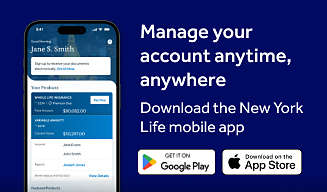While the definition of disability varies slightly by company, New York Life defines disability as the inability to perform the substantial and material duties of your “own occupation” and will pay benefits for the first 24 months of your claim. Afterwards, our policy provides”any occupation” coverage which pays benefits if you are unable to perform any occupation consistent with your education, training, and experience. In some cases, you may be able to enhance the definition of disability by adding an "Extended Own Occupation" or "True Own Occupation" rider. For an additional fee, these optional riders will allow you to enjoy “own occupation” coverage for the life of your policy.
Can I Get Disability Insurance if I’m Self Employed?

Individual disability insurance is a solid option
While many people have access to group disability insurance through their employer, this type of coverage is often not available to small business owners and other self-employed professionals. Fortunately, most people in this situation can secure similar, and in many cases, more protection by purchasing an individual disability insurance policy from an insurance company.
It protects your ability to earn
If you’re like most of us, your income is vital to you and your family. It’s the cornerstone of your finances. It keeps a roof over your head, food on the table, and helps you build a more secure future. As part of a protection-first financial strategy, individual disability insurance can help protect you and your family in the event of future loss of income due to a disabling sickness or injury that leaves you unable to perform the material duties of your occupation.
Here’s how it works
If you become disabled while this coverage is in place, you may be eligible to receive monthly disability benefit payments that you can use to help financially support your loved ones and maintain your quality of life. Payments begin at the end of your Elimination Period (an amount of time specified in your policy) and are sometimes free from federal income taxes depending on how you fund the policy. Unlike health insurance payments, disability benefits are paid directly to you, so you are free to use them however you like. In most cases, these payments will continue until you are able to return to work, or until the end of your benefit period, whichever comes first.1
Why does disability insurance make sense for the self-employed?
Over the course of their lifetime, 1 in 4 people in the workforce will become disabled and potentially face financial hardship at some point during their lives2. If you’re a self-employed professional, this can be especially difficult because there may not be anyone who is qualified to step in—even temporarily—to keep things running during your absence. With individual disability insurance in place, you will receive a steady flow of benefit payments that can help fill the financial gap caused by your absence.

How does individual disability insurance work for small-business owners?
Individual disability insurance can be particularly helpful if you are a small business owner because the monthly disability benefits you receive can be used any way you want. Since there are no restrictions, you can use your benefits to pay personal expenses or to help sustain your business. For an additional cost, you may be able to add some optional riders that were designed to give business owners an extra layer protection. Here are two that are currently available on our MyIncome Protector policies:
- Business Support Rider: With this rider, you will receive an additional benefit that you can use to help cover ongoing business expenses while you’re disabled.
- Business Loan Rider: As the name suggests, this rider is designed to help pay all, or part of, the monthly loan payments you or your business are obligated to pay on a loan.
Replaces more than just your salary
In addition to replacing a portion of your salary, individual disability insurance policies typically help replace other types of compensation. While benefits vary by policy, most generally cover bonuses, pension or profit sharing contributions, business profits, contributions on your behalf to a qualified or nonqualified retirement plan, and other payments for work or professional services.
Can be customized to meet your needs
Unlike group disability products that typically offer a pre-determined set of benefits, individual disability products often give you a greater selection of benefits. In fact, we offer three types of coverage on our MyIncome Protector policy:
- Base Coverage: To keep costs down, this option provides benefits for two years if you cannot perform the duties of your specific occupation (otherwise known as “Own Occupation” coverage.) Afterwards, the definition of disability changes to “Any Occupation” and your policy continues to pay benefits if you are unable to perform any occupation consistent with your education, training, and experience.
- Extended Own Occupation: For an additional cost, you can add a rider that expands the length of time that you will be eligible to receive benefits if you are unable to perform the substantial and material duties of your specific occupation. Once the rider is added, your policy will provide “Own Occupation” coverage for the full benefit period identified in your policy.
- True Own Occupation: By adding this rider, you will be eligible to receive benefits if you are unable to perform the substantial and material duties of your own occupation—even if you decide to work in an occupation that is different from the one you previously held. Despite being gainfully employed, the “own occupation” definition of disability will apply for the duration of your policy.
Riders can add extra value
One of the important features of individual disability insurance is the possibility of adding riders that customize your protection to your situation. Riders are additional features that you can add to your policy for an additional fee. There are riders that help with student loans payments, making sure your benefits keep up with inflation, and even allow you to receive benefits for a period of time after you return to work. The availability and diversity of riders depends on the company that issues your policy. Working with an insurance agent or financial advisor can help you determine what policy and corresponding riders are best for you.3
It’s yours to keep
With individual disability insurance, you own the policy so you can customize it however you like. What’s more, this coverage is portable. As long as you continue to pay your premiums, you can take this coverage with you wherever you go—even if you decide to change careers or join another company.
Frequently Asked Questions
By providing valuable income protection and a host of flexible benefits, individual disability insurance makes sense for credentialled professionals such as attorneys, accountants and physicians, small business owners, or anyone who wants to make sure their lifestyle and future remain secure.
The cost of individual disability insurance is determined by the policy and benefits you select, as well as the rate classification you receive in underwriting. That’s why it’s so important to work with a financial professional who will take your needs and budget into consideration and create a customized solution that’s right for you.
Individual disability insurance is available from a variety of insurers. New York Life’s MyIncome Protector provides individual disability coverage whether you’re a self-employed professional, a small-business owner, or an employee at a firm or corporation. It offers a selection of valuable riders and is backed by the financial strength of a company that has been there for its clients for more than 175 years.4
RELATED CONTENT
To learn more about how MyIncome Protector can safeguard your income and lifestyle, talk to a New York Life financial professional today.
1For New York Life MyIncome Protector, the length of coverage for benefit payments can be two years, five years, 10 years, to age 65, to age 67, and to age 70.
2Social Security Administration, Social Security Basic Facts, 2023
3Riders are available at an additional cost. Premiums, available benefits, and terms of coverage vary based on coverage levels and riders selected. Not all riders are available in every state, and some states vary the terms of certain riders. Not all riders are available with all benefit periods, occupation classes or issue ages. Additional limitations and conditions may apply. Please speak to your New York Life financial professional for complete information.
4New York Life Insurance Company and New York Life Insurance and Annuity Corporation have received the highest financial strength ratings currently awarded to any U.S. life insurer by A.M. Best (A++), Fitch (AAA), Moody’s (Aa1), and Standard & Poor’s (AA+). Source: Individual Third-Party Ratings Reports as of 8/1/2025.






